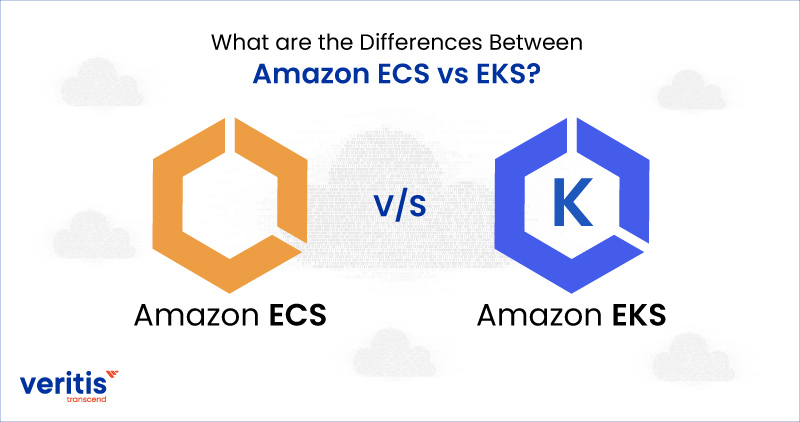
In today’s business environment, it’s more important than ever to scale applications fast and securely while monitoring resource usage and cost reduction. Containers provide a standard way to group your program’s configurations, dependencies, and code into a single object. Instead of doing hardware stack virtualization, they do it at the operating system level. On top of the OS kernel, users can directly run several containers.
They can be essential to the success of your cloud environment because they are faster, more portable, and more memory-efficient than virtual machines. However, managing containers at a large scale, or container orchestration, can be confusing.
In this post, we’ll evaluate and compare the two well-known container orchestration systems, Amazon ECS and EKS, to assist you in better deciding which is best for your organization.
What is AWS ECS?
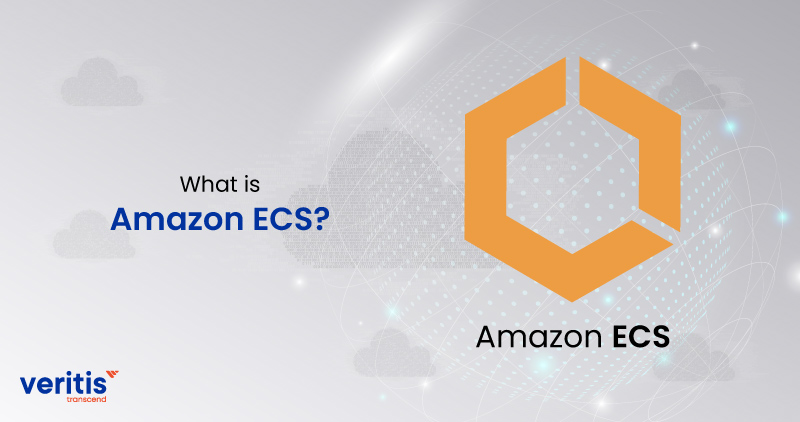
Elastic Container Service (ECS) is a lightning-quick and extremely scalable container management solution. ECS makes managing containers very simple and involves actions like start/stop. In ECS, a task definition within a service defines a container. A service configuration manages and executes a set number of tasks in a cluster. Tasks may occur on an AWS Fargate-managed serverless architecture or a user-managed cluster of Amazon EC2 instances.
ECS is designed to operate at scale and provides high availability and security. In addition, it is tightly integrated with several AWS managed services, including Elastic Load Balancing, Amazon VPC, and AWS IAM.
You can manage EC2 instances using Auto Scaling groups to keep up with your application’s increasing demands. If you want to manage the scaling, use the managed scaling functionality. ECS develops a scaling strategy based on the desired capacity you supply, assisting you in scaling up or down as necessary without going out of control.
This completely controlled solution is not available in Kubernetes on AWS. Instead, you must manually configure requests and limitations and the Horizontal Pod Autoscaler (HPA), Cluster Autoscaler, and Worker Node Autoscaler to control the number of replicas and CPU usage.
With Container Insights, you can use Amazon CloudWatch to aggregate and monitor your ECS and EKS metrics. Your AWS container resources can be tracked in one location, allowing you to track metrics such as CPU and memory usage, storage utilization, task, service, and instance counts. You can also set alarms and troubleshoot all of your AWS container resources. ECS Cluster, Service, and Task, or EKS Cluster, namespace, service, or pods, are two ways to filter these metrics.
ECS integrates with Prometheus and other third-party monitoring tools via CloudWatch, native ingestion using a sidecar container, or fluentbit/fluentd. However, these technologies are most frequently used in Kubernetes environments. Grafana dashboards and Prometheus can also be used to visualize your ECS information.
ECS has advantages over EKS, such as being easier to use, requiring less management overhead and specialized knowledge, and being more cost-effective (although at the expense of flexibility).
Benefits of Amazon ECS
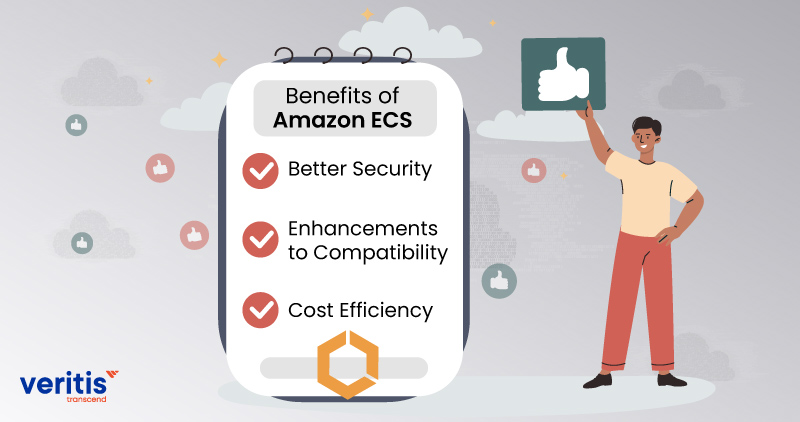
Amazon ECS has been able to guide systems managers and administrators by offering automated deployment and rollback options, on-demand scalability, and disaster recovery made simple.
Several years ago, developers and administrators used Perl and Bash scripts to automate deployments, modify configurations, and fix problems. Today’s containers are lightweight, quickly deployable, and individually isolable, enabling easy distribution across numerous endpoints.
1) Better Security
Combining Amazon ECR with ECS offers additional security advantages. For instance, system administrators can limit access to particular S3 buckets and other Amazon AWS resources with granular control levels and automated image encryption. In addition, IAM roles with ECS add a layer of security that isn’t necessarily present in other conventional environments.
2) Enhancements to Compatibility
The EC2 Container Registry (ECR), a feature of Amazon AWS, is connected to Amazon ECS. Using Amazon ECS and ECR can help organizations streamline troubleshooting procedures and reduce the instances where development takes place across different environments. In addition, ECR enables developers to retrieve instance images currently used in production, which can be shared for quicker debugging. Debugging workflows that are thus simplified increases compatibility by bringing parity between various working environments.
3) Cost Efficiency
With features that give businesses ready-made container deployment and administration capabilities, Amazon ECS gets teams up and going immediately. In addition, teams can schedule multiple containers on a single endpoint using Amazon ECS, increasing EC2 instance density.
Key Features of Amazon ECS
Thanks to Amazon Elastic Container Service (Amazon ECS), installing containerized workloads on AWS is simple. With Amazon ECS’s robust simplicity, you can scale from managing a single Docker container to your entire enterprise application portfolio. Run and scale your container workloads in the cloud, on-premises, and across availability zones without dealing with the hassle of managing a control plane or nodes.
1) AWS Fargate
AWS Fargate gives teams control over scaling and infrastructure management, letting them concentrate more on development. And less on issues such as EC2 instance forms, provisioning, cluster setup, and patch management.
2) Programmatic Control
Developers can use API calls to integrate and expand their services using Amazon ECS. For instance, simple API activities or CloudFormation for provisioning can use to create, delete, and manage clusters.
3) Native Docker Support
Teams can run and manage Docker containers since Amazon ECS has built-in support for Docker. Without setting up changes, teams may bundle applications locally and deploy them at scale using Amazon ECS.
4) Scheduling
Teams might use various scheduling techniques. Amazon ECS may schedule clusters depending on a range of requirements, including resource requirements for CPU or RAM or whether your team needs a certain number of jobs to execute simultaneously.
5) Container Auto Recovery
Amazon ECS automatically restores failed containers to maintain your application’s availability and dependability above 99.99% uptime.
What is AWS EKS?
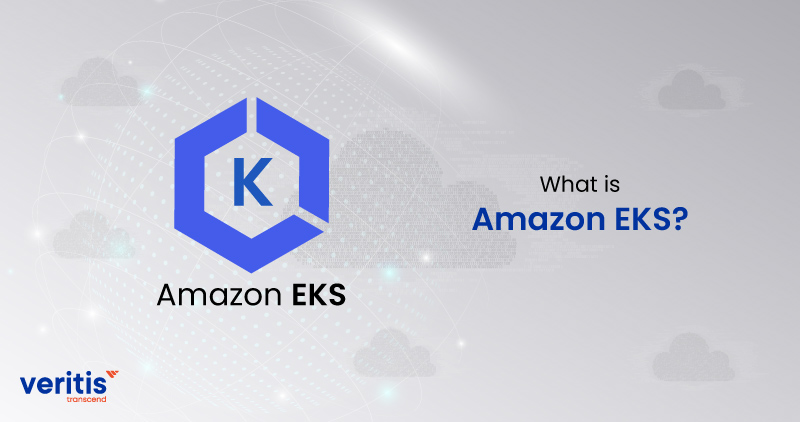
With the help of Amazon Elastic Container Service for Kubernetes (Amazon EKS), it is simple to deploy, manage, and scale containerized applications using Kubernetes on AWS. Furthermore, this service uses open-source Kubernetes, and all applications managed by Amazon EKS are entirely interoperable with applications managed by any regular Kubernetes on the AWS EKS architecture environment. In this regard, Amazon EKS is more extensible than Amazon ECS.
Let’s take a step back to better understand Amazon EKS. First, here is a detailed description of Kubernetes.
Useful link: Managing Kubernetes Applications Through Terraform and AWS EKS
What is Kubernetes?
An open-source platform called Kubernetes enables businesses to scale up the deployment and management of containerized cloud applications, including platforms as a service (PaaS), batch-processing workers, and microservices. Development teams can let Kubernetes handle various tasks, such as load balancing, monitoring, and controlling resource consumption. For instance, workflows can be built on top of a host collection while utilizing extra resources from newly added hosts to a cluster and limiting resource consumption.
Organizations using AWS managed services can access all Kubernetes’ features through Amazon EKS without setting up or maintaining the essential software.
Benefits of Amazon EKS
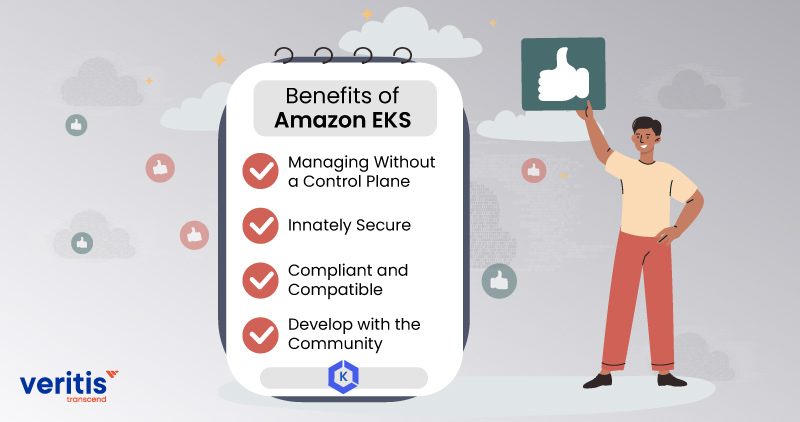
With Amazon EKS’s fully managed service, you can enjoy Kubernetes’ benefits without hiring an internal specialist to look after the infrastructure. EKS automates load balancing and parallel processing faster and more effectively, allowing administrators to concentrate on their clusters and workloads.
1) Managing Without a Control Plane
AWS EKS provides on-demand upgrades and patching and administers the Kubernetes on AWS management architecture across several AWS Availability Zones. It automatically identifies and replaces faulty control plane nodes. A straightforward configuration is needed to connect worker nodes to the provided AWS EKS architecture endpoint.
2) Innately Secure
Your infrastructure running on Amazon EKS is highly secure because more vigilant and encrypted communication pathways between your worker nodes and the managed control plane are automatically created.
3) Compliant and Compatible
Because Amazon EKS runs upstream Kubernetes and is certified as Kubernetes conformant. Thus, the applications it manages are compatible with those managed by any standard Kubernetes on the AWS environment.
4) Develop with the Community
Whenever engaging with the Kubernetes community, Amazon Web Services actively contributes to the code base, allowing Amazon EKS users to use Amazon Web Services capabilities.
Key Features of Amazon EKS
Some of the key features of the Amazon EKS-managed Kubernetes service are listed below:
1) Enhanced Security
EKS allows access to third-party and Amazon services that improve security, such as AWS Identity and Access Management (IAM) and Amazon Key Management Service, as well as a built-in secure Kubernetes configuration (KMS).
2) Load Balancing
EKS enables the usage of any ingress controller or standard Kubernetes load balancing. In addition, you have the choice of using an Application Load Balancer (ALB), Network Load Balancer (NLB), or Traditional Load Balancer if you wish to leverage Amazon services for load balancing (CLB).
3) Managed Control Panel
EKS runs Kubernetes control plane components, expands them automatically as necessary, and ensures high availability by operating them across three availability zones (AZs) and automatically fixing masters.
4) Managed Cluster Updates
EKS eliminates the need to create new clusters or move workloads. Instead, existing clusters can update, and workloads are transparently transferred to the new cluster.
5) AWS IAM
Granular access control for the Kubernetes control plane is made possible in an EKS cluster by the automated integration of Kubernetes role-based access control (RBAC) with Amazon IAM authenticator. Moreover, the service provides IAM management for Kubernetes service accounts, which may also be assigned to outside applications.
Useful link: Top 7 AWS Cost Optimization Tools
Comparison Between Amazon ECS Vs EKS
The difference between Amazon ECS Vs EKS is that both deliver outstanding performance. EKS can scale to match your demands and is intended to be highly available. Although extraordinarily scalable and highly accessible, ECS is less effective than EKS.
| Parameters | Amazon ECS | Amazon EKS |
| Ease of Use | It does not need a control plane because it is a native product and is made to function with little resource provisioning. | Although easier to manage than upstream K8s, it requires some configuration and skill to set up and run. |
| Scalability | Scalable and highly available. Furthermore, it also offers automated scaling without human configuration. | High availability and scalability. Nevertheless, it necessitates explicit setting of requests, parameters, and the Horizontal Pod Autoscaler. Alternatively, AWS Autoscaler must be added independently. |
| Compatibility and Portability | It needs more mobility because most Amazon services are only natively compatible with it. | It is a managed K8s service that you can use with any infrastructure, whether on-premises or in the cloud, boosting vendor portability and reducing vendor-lock-in. |
| Monitoring | With built-in monitoring provided by AWS CloudWatch, Container Insights, and support for external monitoring tools, you may get information about the condition and efficiency of your tasks. | While GuardDuty improves further K8s audit logs analysis, Amazon CloudWatch, Container Insights, and CloudTrail already support built-in monitoring. |
| Pricing Model | You only need to pay for the resources your containers use. | For each EKS cluster you operate, you must pay an additional USD 0.10 per hour. In addition, EBS volumes and other supplementary resources have additional launch fees. |
| Networking Limit | Assigns an Elastic Network Interface (ENI) to a task in Amazon VPC mode. Then does up to 120 tasks per EC2 instance (higher with unique prerequisites). | It gives K8s pods a private IP address on a dedicated network interface. Then, each instance runs up to 750 pods and splits ENI among the pods. |
| AWS Identity and Access Management (IAM) Support | Provides native support for deep integration with IAM, enabling IAM roles down to the task or container level. | We need a few add-ons (like KIAM) to provide deep integration with IAM at the pod level, which raises complexity and may increase the cost. |
| Supports | The technical team at Amazon offers support programs, documentation, and training. | Support system based in the community. |
| Cluster Management | It prevents changing instance types or relocating container instances to different clusters after deployment. But supports many containers due to the ability to duplicate environments through AWS SDK/CLI calls. | Restricts replication to up to three masters in various Availability Zones (you must open a support ticket to gain more) and up to five control plane security groups. |
| Compatible with AWS Fargate serverless compute | Yes | Yes |
Conclusion
As mentioned, container orchestration is a requirement, not an add-on, when running your application in the container world. In this blog, we covered the essential differences between Amazon ECS and EKS and looked at the variations of these two managed services provided by AWS. Depending on your requirements, each option will have different advantages or disadvantages.
ECS can be the best option when you are unfamiliar with containers and searching for a quick solution. On the other hand, if you are an experienced user seeking a better approach to growing your cluster or application, EKS should work well for you.
ECS can assist you if you need and are firmly dependent on AWS alone. However, EKS is the option if you want to concentrate on Kubernetes and not be permanently tied to Amazon. With our AWS Managed Services, Veritis, the Stevie Award winner, can assist you in designing, deploying, and maintaining your application on AWS, whether you select Amazon ECS or EKS.
Got Questions? Schedule A Call
Also Read:
- Choosing the Right AWS EC2 Instance Type for Your Application
- Kubernetes Vs. OpenShift: Which One Should You Choose?
- Managing Kubernetes Applications Through Terraform and AWS EKS
- Amazon Web Services (AWS’s) Impressive Growth Fails to Fuel Amazon’s Profitability
- AWS vs Azure vs GCP: Cloud Cost Comparison
- Which Cloud has Better Private Connectivity: AWS or Azure or GCP?